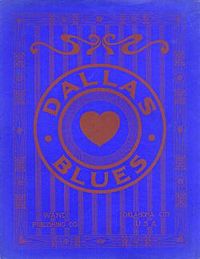- Dallas Blues
-
"Dallas Blues" 
Sheet Music 1912Written by Hart A. Wand Published March 1912 Language English Form Twelve bar blues Original artist Sheet music Recorded by Jazz standard "Dallas Blues", written by Hart Wand, was the first true blues song ever published.[1] "Oh, You Beautiful Doll", a Tin Pan Alley song whose first verse is twelve-bar blues, had been published a year earlier. Also, two other songs with blues in their titles were published in 1912; "Baby Seals Blues" (August 1912), a vaudeville tune written by Arthur "Baby" Seales, and "The Memphis Blues", written by W.C. Handy (September 1912).[2][3] Neither, however, were genuine blues songs.[4]
The song, although written for standard blues tempo (Tempo di Blues. Very slowly)[5], is often performed as Ragtime or Dixieland.
In 1918, Lloyd Garrett added lyrics[6] to reflect the singer's longing for Dallas:
- There's a place I know, folks won't pass me by,
- Dallas, Texas, that's the town, I cry, oh hear me cry.
- And I'm going back, going back to stay there 'til I die, until I die.
No date is found for the actual composition of "Dallas Blues" but Samuel Charters, who interviewed Wand for his book, The Country Blues (1959), states that Wand took the tune to a piano playing friend, Annabelle Robbins, who arranged the music for him.[7] Charters further states that the title came one of Wand's father's workmen who remarked that the tune gave him the blues to go back to Dallas. Since Wand's father died in 1909, the actual composition must have predated that.
In any case, within weeks of its publication it was heard the length of the Mississippi River,[8] and its influence on all the blues music that followed is well documented.
Contents
Early recordings
Early recordings. Date Artists Label 1918 Wilbur Sweatman's Jazz Band Columbia A-2663 1925 Fred Hall's Sugar Babies Okeh 40437 1925 Lee Morse Perfect 11582 1927 Bob Fuller Brunswick 7006 1929 Louis Armstrong & His Orchestra Okeh 8774 1930 Andy Kirk's 12 Clouds of Joy Brunswick 6129 1931 Ted Lewis & His Band (v. Fats Waller) Oriole 3132 1934 Isham Jones & His Orchestra Victor 24649 1936 Wingy Manone & His Orchestra Bluebird 6375A 1939 Woody Herman & His Orchestra Decca 2629A References
- ^ Duncan, Blues Fiddling Classics, page 30: "This tune was the first 12-bar blues to be published (March 1912). It was written by violinist/band leader Hart Wand from Oklahoma."
- ^ Davis, The History of the Blues, page 59: "But in a sense, the very first blues was the twelve-bar opening verse to the pop song "Oh, You Beautiful Doll," which was published in 1911."
- ^ Davis, The History of the Blues, page 59: "The composer of the very first copyright "blues" was Hart Wand, a white Oklahoma violinist and bandleader whose "Dallas Blues" was so named because its melody gave a black porter who worked for Wand's family "the blues to go back to Dallas." This was followed a few months later by "Bably Seal Blues", a negligible item by the black vaudeville performer Arthur"Baby" Seals and ragtime pianist Arthur Matthews."
- ^ Charters, The Country Blues, pages 34-35: "The first was Hart Wand's "Dallas Blues," published in March; the second was Arthur Seals's "Bab Seals' Blues," published in August; Handy finally brought out his blues in September. Both Handy and Arthur Seals were Negroes, but the music that they titled "blues is more or less derived from the standard popular musical styles of the "coon-song" and "cake-walk" type. It is ironic the first published piece in the Negro "blues idiom, "Dallas Blues,' was by a white man, Hart Wand."
- ^ Wand, "Dallas Blues", p. 2
- ^ Jasen, A Century of American Popular Music, page 45: "Dallas Blues"; Wand Publishing Co.—Oklahoma City, 1912; Probably the first published blues number. Words were added (by Lloyd Garrett in 1918). Although a favorite of dance and jazz bands, Ted Lewis and His Band had the number 7 hit in 1931, with Fats Waller as vocalist (Columbia 2527-D).
- ^ Charters, The Country Blues, page 35.
- ^ Charters, The Country Blues, page 36: "Twenty bars in all, it was easy to play and whistle, and within a few weeks it was a favorite the length of the Mississippi River."
Bibliography
- Charters, Samuel B. The Country Blues. Da Capo Press, 1975. ISBN 0-306-80014-4
- Davis, Francis. The History Of The Blues: The Roots, The Music, The People. Da Capo Press, 2003. ISBN 0-306-81295-7
- Duncan, Craig. Blues Fiddling Classics. Mel Bay Publications, 1994. ISBN 0-7866-1855-8
- Jasen, David A. A Century of American Popular Music: 1899-1999. Routledge, 2002. ISBN 0-415-93700-0
- Wand, Hart A. "Dallas Blues". Wand Publishing Co., 1912. From Mississippi State University's Templeton Digital Sheet Music Collection.
- Wand, Hart A. (music); Lloyd Garrett (words). "Dallas Blues". Frank Root & Company, c. 1918. From the University of Colorado Digital Sheet Music Collection.
External links
- YouTube
-
- "Dallas Blues" (Tempo di Blues) New Optimus Orchestra—Linköping, Sweden (7.06 min).
- "Dallas Blues" (Dixieland) Bob Schulz Frisco Jazz Band—Puget Sound Traditional Jazz Society (5.23 min).
- "Dallas Blues" (Dixieland) Titanic Jazz Band—Orange County Classic Jazz Festival (4.45).
Blues Subgenres Fusion genres Regional scenes British blues · Canadian blues · Chicago blues · Detroit blues · East Coast blues · Gospel blues · Hokum · Kansas City blues · Louisiana blues · Memphis blues · New Orleans blues · New York blues · Piedmont blues · St. Louis blues · Swamp blues · Texas blues · West Coast blues · Hill country bluesInstruments Other topics Lists  Book ·
Book ·  Category ·
Category ·  PortalCategories:
PortalCategories:- Blues songs
- 1912 songs
- Music of Oklahoma
Wikimedia Foundation. 2010.
